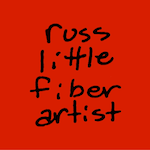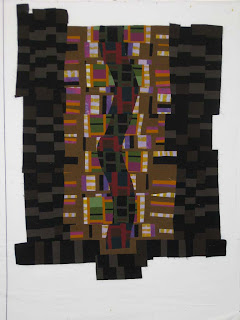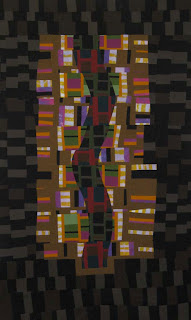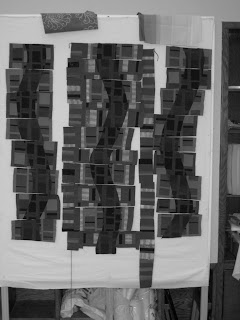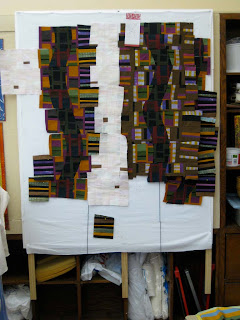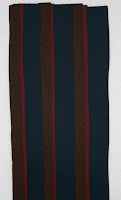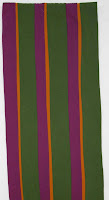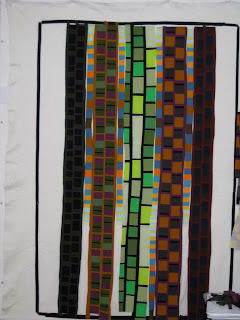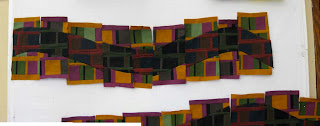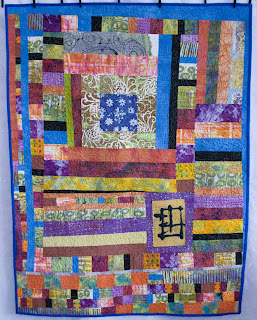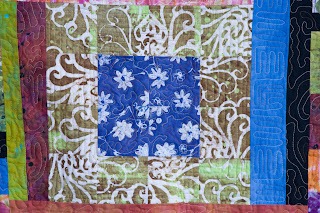
Thoughts & news
Dyeing to Discharge: Day 5
Well, actually this post is more like post-day 5. I'm home in College Park and exhausted. I can't figure out what I did to be so pooped except that I must have worked harder this week than I thought.
- First and foremost: I've been ignoring a really valuable design tool--discharge--because I was squeamish about the safety, mess, etc. After a week of working with this stuff and never feeling any ill effects I feel well prepared to do more discharge work, and to do it in a way that's safe.
- Tied for first: This stuff is great, but anyone using any form of bleach or reducing agent needs to wear a respirator when using it and work outside. [That goes for using Tilex in the bathroom too. Close the door, open the window, turn on the fan, wear an acid/gas respirator, leave the room when you're done, and don't come back until the smell is gone. Don't laugh. I'm totally serious. I've made myself sick in the past from chlorine and I will never do it again.]
- I'm going to try a few more experiments with MX primary combinations and work on developing a vocabulary of discharge colors, effects, and marks that speaks to me. In a lot of ways workshops like this one are like going to a wine tasting. You taste some things you like and some you don't, and after a while your palette needs a rest to recover from the over-stimulation.
- MX acid process for silk! I've got to do more of this. I've got all of the supplies; I just need to fine tune my technique. [Of course Carol teaches a 5-day action packed class just on silk, but I can't think about that now. Too tired.]
- I want to work on black and white textures through discharge. Is it really possible that there's a pleasing combination of MX primaries out there that discharges to white? It doesn't seem that way, but...
- I'm going to experiment with potato dextrin as a resist and see if I can use it in a way that works for me. I'm not really interested in slathering yardage and waiting for it to crackle, but the stuff washes out so much easier than some other resists that it's worth playing with.
- Finally, I bought some monagum [the giant PRO Chem order should arrive on Wed] and I'm going to make my own thickened bleach discharge paste from now on. No more dishwasher gel.
Bottom line: I learned some new things and a lot of good safety tips. I definitely recommend this workshop for anyone interested in working with discharge techniques. Yes, you can figure this stuff out on your own, but this is a great way to jumpstart the process and get a good and SAFE start.
Dyeing to Discharge: Day 4
Yesterday was the 4th day of class. Time is flying by--faster than usual. The sample books are all done and it will be a valuable reference. As I was replaying the day in my head last night I started thinking about the work hanging on my design wall at home. One of the things that I wanted to accomplish this week was to work on new ideas for how I would add complexity to that composition through discharge. I've got some ideas, so mission accomplished.
Dyeing to Discharge: Day 2
Another good day, but that's not really a surprise. I think I could actually take this class at a faster pace, but the group is a mixture of folks who have previously studied with Carol and some who haven't. Everyone has had some MX experience, so that's helping move things along.
A week in Fall River
I'm in Fall River at PRO Chemical for a 1-week workshop with Carol Soderlund called "Dyeing to Discharge." It's hard to believe, but this will be my 5th class with Carol. I'm going to have to ask for a degree soon.
"Unexpected Patterns" opens today
"Unexpected Patterns" (aka "Unexpected Patterns: Quake!") opens today at the Worcester Center for Crafts in Worcester, MA. If you're in the area check out my piece in this show along with the other outstanding work by members of the Art Cloth Network.
Saving the hopeless quilt: Part 4
As I began to assemble it I realized that the little piece of the curved middle strip that was extending below the rest of the design was something to which I'd become attached. From the purely practical perspective of construction, this was not the best time to come to this realization because it meant even more seam ripping than I was already doing, not to mention scavenging through the scrap pile in search of bits of fabric that I was out of.

Saving the hopeless quilt: Part 3
Saving the hopeless quilt: Part 2
Picking up where I left off with the last post...
Saving the hopeless quilt: Part 1
Back in October I returned from two weeks of workshops in a sort of mixed up mood. One week produced some good samples and good ideas, the majority of which I've yet to explore. The other week produced bits and scraps of a failed design that quite frankly were just a nagging reminder of something that didn't quite turn out as expected. They can't all be home runs, right? Sometimes teacher, student, and the planets just don't align the right way at the right time. Learn what you can, remember the love, try to forget the angst, and move on.
Recently finished
Just in time for Christmas, I finally finished a commission quilt that I started *months* ago. Thanks for being so patient Jennifer. Aaron, I hope you like it. By the time I was done I almost didn't want to let it go. That's a good sign.
Layers upon Layers: Day 5 and beyond
I've been home from Ohio for a week. I drove home last Saturday and I'm please to say that all went well with the trip. I've been having trouble with my eyes for the last year (since the surgery) and I was really concerned about managing a 6.5 hour car trip without any double vision or ocular migraines, both of which are triggered by stress, fatigue, and eye strain. It was smooth sailing. So anyway, the last day at the Barn was good. I did some tests with fabric paint using materials and methods that I hadn't used before. I've always screened, painted, or printed with fabric paint and other acrylics, but rollering/rubbing (which I've done successfully with dye) was new to me. I'm happy with the results and I think I've got some ideas for some new layering.
The first shot below shows a transparent paint (mixed from ProFab Extender and pigment). All 4 images were created from a simple collograph:
- Upper left: rollering paint with a dense foam roller over fabric placed on top of the plate
- Lower left: rollering paint onto the printing plate then hand rubbing a print with dry fabric
- Lower right: same as #2 but with fabric lightly dampened with a spray bottle
- Upper right: a sort of modified monotype print created by rollering paint onto plastic sheeting then stacking the printing plate, fabric and plastic sheeting (paint side down) and rubbing.
This second image is a set of similar prints made with opaque black ProFab paint.
- Upper left: rollering paint with a dense foam roller over fabric placed on top of the plate
- Upper right: rollering paint onto the printing plate then hand rubbing a print with slightly damp fabric
- Lower left: a print taken by rollering over some yarn couched to a piece of fabric (instead of the collograph.
- Lower right: the collograph plate after all was said and done.
Lessons
- There's layering potential here.
- The couched yarn is the most exciting image.
- The roller imparts a certain amount of texture on its own.
- A small roller creates marks that contribute to the overall story/feeling of the print. perhaps more than a wider roller would.
- I'm going to start mixing all of my paint from primary pigments instead of primary paints. There's more control and it makes more sense than holding an inventory of aging paint in colors that I might use infrequently.
Bottom line for the week
Carol's new class was great and I recommend it for anyone who is interested in exploring the concepts of layering line, shape, technique, texture, color, and meaning; all while playing with sequence of those things. I've taken both of Carol's color mixing classes and definitely benefited from that experience in this class because I had no anxiety about handing the dye primaries. That said, there were quite a few people in the class who did not have that experience and got along just fine with the hand outs and some direction from Carol. Basically it's a good class for any surface designer looking for a time and space to try new things and have their familiar ways of working shaken up a bit.
Layers Upon Layers: Days 1-3
I think I'm getting some good work done this week. I'm still at the Barn, but this week taking Carol Soderlund's new class, "Layers Upon Layers." I'm glad that I've already taken Color Mixing I & II because I can focus the sequence of process and on color and zone out a little bit on the during some of the "How does this work?" question. Now, having said that I can also say that I've learned some new things about starch resists and fabric paint.
Back to the Barn
Yesterday I got a massage (truly wonderful and cheap compared to DC prices), had a little nosh, bought supplies for Carol's class (including dye studio clothes, which I didn't bring with me), watched a movie, napped, ate chinese takeout, and when to bed. After last week I was exhausted and a day of nothing was just what I needed.
It was the best of strip piecing; it was the worst of strip piecing
Now I AM trying to be coy with that title, but it has been a most unusual and unexpected week. In fact it's been one of the more disturbing weeks in recent memory; not quite in the same class as my surgery week, but up there with some of the recovery weeks. I'm physically fine, though still trying to shake the last vestiges of the creeping crud that seems to be pandemic at this point. Mentally--I've got a little healing to do in the next 2 days. So, let me start by saying that Nancy Crow is wonderful, committed, nurturing, and keenly observant of each of her students' needs, capabilities, and struggles; and she pushes each person to do his or her best in her classes. Given a chance, I will likely take another class from her. But...I won't be taking the class that I was signed up to take starting on Monday, "Strip piecing and restructuring."
Something bad happened this week and I'm having trouble putting my finger on just what it was or exactly what caused it. The best description that I can give is that while I'm certainly at a point in my development as an artist where work on composition is needed, strip piecing does not seem to be a good vehicle for doing so. The first day and the first composition went well. I even enjoyed working in black and white; I might even do more of that on my own. We began the second composition (4 x 6 feet) Thursday afternoon with a deadline of 4 PM Friday. The assignment was to create a strip quilt composition using the strip-pieced fabrics that we had created Tues-Thurs AM. We were to make substantial use of restructuring in the composition, not just string together strips of strip-pieced fabric. I was totally and utterly blocked. I HAVE DONE THIS MANY TIMES BEFORE. Why was it so hard in this class? Anyone who knows me will be horrified and just as mystified as I am to hear that I did not finish my composition and that, while it had interesting elements, it was in my opinion worthy of being ripped off the wall.
This happens to everyone involved in any creative pursuit. There are times when you need to rip the page out of the typewriter, paint over the canvas, or rip the quilt off the design wall. That said, a workshop is a free and open time to be wild and take risk. Somehow I just shut down. In a nutshell I was the seed that failed to germinate. WTF!
Nancy saw this and felt the--what were her words, "radiating anxiety"? So now I feel like a bit of a failure, but I'm processing it. Here are my takeaways so far:
- I learned some valuable things about figure/ground relationships, value, and proportion this week.
- I learned that I can sew a lot in 65 hours and that if I focus and avoid procrastination I can produce more work that I am currently producing.
- I'm going to rework my studio space to have a larger design wall, a different work/cutting table, and less display space.
- I'm not going to be throwing out my ruler any time soon, but I'm going to do much more freehand cutting and change some of my other construction techniques.
Perhaps the biggest takeaway (and I'm trying not to use this as an excuse) is that I think part of the problem this week was that I am (a) rather more willful than I care to admit, and (b) more committed than I realized to the layered manner in which I'm currently working and the motifs on which I've been focused. Stitching strips and dealing with lines and rectilinear shapes is the antithesis of the circles and curves to which I'm currently drawn.
Yesterday I had alternating conversations with Nancy and Carol Soderlund, who's been teaching a dye class in the wet studio this week and with whom I've taken two classes. Next week Carol is teaching a new class called "Layers upon layers," which is pretty much exactly the way that I work. That's where I belong right now. I wrestled for quite a while with the concern that I might be running toward what is familiar and easy. I don't think that's the case and I've asked Carol to offer hard criticism and challenge me. I'm sure I'll add a few new techniques to my bag of tricks, but my goal is to focus on this circular motif and ways that I can use and restructure it in more sophisticated compositions. Nancy graciously offered me the option of doing a independent study with her upstairs, but as much as I intend to do stitched composition next week, I also need access to the wet studio printing/painting/dying resources.
I still feel a bit like a Nancy Crow drop out, but perhaps it's more that I changed majors. I hope to get the train back on the tracks next week. Wish me luck.
Best of Strip Piecing: Days 3 & 4
Tues 15.5 hours.
Best of Strip Piecing: Day 2
Up a 630 and at the Barn by 8 to tidy up and get organized. Critique started at 9 with me first! It went well and I'm pleased with the Monday composition (see yesterday's updated post). I learned some things from it and I learned as well from hearing Nancy's critique of the other student's excellent work. It's a strong group.
Best of Strip Piecing I and II with Nancy Crow
I'm in Ohio for two back-to-back workshops with Nancy Crow. Today was day one. As advertised, she runs her classroom like a graduate seminar. In fact, graduate school is the last time I worked this hard. I was there at 9 AM and left at 10 PM but I did manage to finish the assignment that will be critiqued tomorrow at 9. It's now almost 11 and I've got to get to bed so I can be there bright and early to tidy up today's project, clean up my work space and get ready for the next wave of work. I hope to have pictures, but not tonight. I'll update this post later with a photo of today's work.
UPDATE: Here's a picture of Monday's composition.
65+ yards and counting
I'm into my 3rd bolt of cloth and I'm building up a nice stash of solid color yardage for my class in Sept (Nancy Crow). I'm learning a lot from the exercise. If nothing else, I've gotten better about keeping lab records. I'm dyeing all of the solids with a full immersion processe. That means mixing and preparing dye and auxiliaries for about30 minutes then standing in front of a bucket for about an hour and a half. I've come up with a setup that lets me do 3 yards at a time. I manually agitate 2 buckets and let my Wonder Washer tend a 3rd yard (with a few quick checks along the way). What is a Wonder Washer you might ask? Well, basically it's like something straight out of an infomercial. It's a table top washing machine that looks just like an old school diaper pail crossbred with an ice cream maker. If you want to see one in action you might check out this slightly odd video of some straight guy doing his laundry http://www.youtube.com/watch?v=vJ4Nix460h4. Of course I bought the thing so who am I to talk about odd.
Anyway, I'm using the Soderlund method. My first family of colors (bright) was all dyed by overdyeing yellow, red, and blue to match samples from my (her) color book. This was really time consuming and I didn't realize that I should be using a different approach until I'd dyed about 30 yards of cloth various values of yellow. I had no choice but to continue with the overdye method to the bitter end. It was worth the work. I'm really pleased with the result.

Next I moved on to a more subdued color family (Earth) and switched to a value gradation method. Carol has a nice formula for creating a 10-step value gradation of a single hue from very light to almost black. I wanted a 6-step and didn't want really light or really dark, so I used the basic method, but came up with my own scale (a log10 progression) that's producing very nice results. It's 4 steps of pure color and 2 steps toned with complement.
This Earth family also produces some really excellent browns and blacks. I'd love to dye nothing but this for a while.
I've still got more solids to dye, but I'm also starting to move on to some prints. It's been a long time since I did any printing with the intent to create yardage (i.e., not art cloth). It's a bit confining not to be able to work big and do whatever I want. The repeating pattern, stripe, grid thing doesn't feel right. I want to discharge and go back into all of the pieces below, but I need to resist for now. I might still do something. I need to let these stew for now. I will probably supplement the stash with some commercial stripes and plaids (Nancy's request--I'm afraid to know what we're going to do with plaid).
Multiple printings with two values of two different colors.
Mono printing combined with batik. This piece and the one above were both overdyed with the same blue as the last step to help unify them.

Well, that's all for now. I'll certainly post more before the class (or at least I "plan" to).
Pattern & Content: Day 5
Well, today was a great end to the week. Here's a picture of my final collection of cloth on the wall (all except for the 3 that are still batching). I wish that you could see the rest of the room. It was amazing.
I'm surprised by the volume of work that I did this week, but also by the amount that I feel that I've grown since last summer. The work that I did here is very different from what I did at Peters Valley: more complex, more complete. I feel good about that.
I had a really good critique session with Kerr. She gave me some very helpful feedback and somethings to think about as a way forward.
The picture below is of the last piece before cleanup. As expected, I was getting a lot looser. With this piece I was using polychromatic screen printing to explore complementary colors and designs that don't incorporate my ubiquitous black lines. I like it. It's big, rough, and basic.
My final observation about this is week is this: what a great group of people. As I said in an earlier post, all of my classmates are accomplished artists, some very much so. More importantly though, they were all open, enthusiastic, and supportive. That contributed tremendously to the success of the class. I feel like we all pushed and supported each other. And, if I'm going to give all due credit, then I must say that this second workshop with Kerr did not disappoint. She's a great teacher and guide. If you're a fiber artist and have not studied with her then you owe it to yourself to seek her out. I also have to say that Nancy and her family are excellent hosts, and chef Margaret did her part by making sure we were wonderfully fed all week. If you've never been to the Barn then it's time to visit the web site (www.nancycrow.com) and start shopping for a workshop. It's a great experience.
So tomorrow morning it's off for home for a couple of days of decompression before work starts on Tuesday. I've also got to get back on my diet and try to drop the pound or two that I picked up this week. I wasn't kidding when I said that Margaret's cooking is top notch!
Pattern & Content: Day 4
Here are some pictures from today. There are a couple of today's pieces that are still batching. One of them is radically different from anything I've done. Those will have to wait until tomorrow.
I'm tired. I've been having a lot of fun, but I've also been pushing kind of hard. Cleanup starts at 3:30 tomorrow. Even though we don't have a full day (i.e., 9 PM), I think I need to slow down a bit. I'm hoping I wake up with a clear head and a good idea for how to end the week. To be honest, I think I could just walk in the woods and hang out in the studio and get a lot out of just being here.
